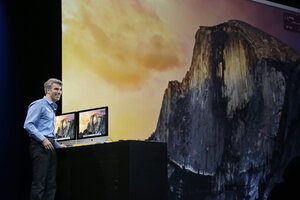At WWDC, Apple blurs the lines between phones and desktops
With its annual WWDC event, Apple unveils a better digital life for customers (assuming they own many Apple devices all at once).

Apple senior vice president of software engineering Craig Federighi speaks in front of a screen for the Yosemite operating system at the Apple Worldwide Developers Conference in San Francisco, Monday, June 2, 2014.
Jeff Chiu/AP
“Connectivity” was a major buzzword at Apple’s annual Worldwide Developer’s Conference (WWDC) in San Francisco on Monday.
Introducing the Mac OS X 10.10 software, called Yosemite, and the new mobile software for iPhone iOS 8, Apple showed key ways in which its devices will more efficiently interact with each other.
Apple software chief Craig Federighi demonstrated iCloud Drive, which will automatically synchronize folders throughout your Apple devices, similar to file-sharing systems such as Google Drive and Dropbox. It is compatible with OS X (for Mac desktops and laptops), iOS (for Apple phones and tablets), and Windows (for PCs). Additionally, a new feature for Apple e-mail called Mail Drop allows users to send large files of up to 5 GB through e-mail via iCloud.
Other developments include Handoff, which makes it easy for Apple devices to sense each other and for Apple users to switch easily between devices. For example, a call to an iPhone could be answered on a Mac desktop.
Families looking to share things such as photos, calendars, and music purchases will be able to do so with Family Sharing, a new feature that, as Mr. Federighi noted, essentially acts as a family refrigerator where relatives might stick reminders and photos for posterity. Up to six family members using the same credit card can use Family Sharing, which also sends parents notifications so they can approve purchases for their kids.
As had been widely anticipated, Apple unveiled plans to streamline fitness tracking with a new app called Health Kit. It compiles information from users’ various fitness apps that are currently available, both from Apple and third-party apps. Until now, users’ fitness information has lived in apps isolated into different “silos,” Federighi explained. Moreover, a partnership with the nonprofit medical group Mayo Clinic will allow medical professionals to view users’ fitness data, which prompts further questions about how this app will change how the healthcare industry interacts with people.
With the announcement of Home Kit, an iOS 8 feature giving users control over household objects from their phones, Apple is making strides toward a cyber world that is increasingly connected to the physical one — the “Internet of Things,” as the initiative has been called. But this also raises important questions about security. As Nick Bilton points out in The New York Times, focus thus far on the “Internet of Things” has given remarkably little attention to what cyberattacks might mean for physical objects. “Hackers can crack governments and corporations, let alone smartphones and desktops. What’s to stop them from hacking a connected house?” Mr. Bilton writes.
Apple did not announce any news about the rumored iPhone 6 and iWatch. This keynote event was more of an opportunity for Apple to announce ways it has streamlined existing features and apps, giving users greater ease and comfort in the ways they shift from one device to another.
OS X 10.10 and iOS 8 are currently available in beta and will be widely available in the fall.

